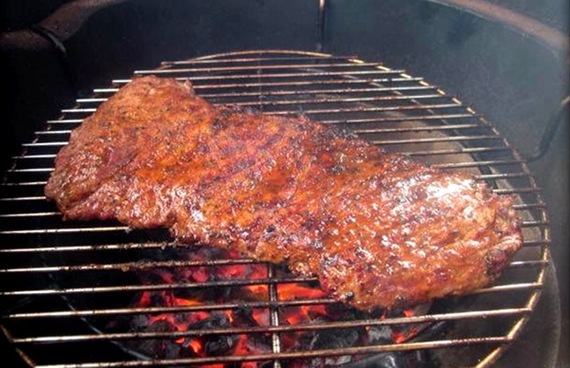There are times when you splurge for big-ticket steak, like porterhouse or filet mignon. And there are also times when you crave the sanguine satisfaction of beef—without straining your credit card. You've got a craving; I have your fix; and it comes from the steer's underbelly. I speak, of course, of skirt steak, and its cousins, flank steak, hanger steak, and flap meat.
These robust steaks have everything a carnivore hungers for: a bold flavor and no-nonsense texture you can sink your teeth into at a price you can afford. All come from well-exercised muscles (unlike beef tenderloin, for example, which owes its fork-tenderness to the fact that it rarely flexes), so all have well-developed muscle fibers and a correspondingly rich flavor.
Anyone can look like a genius cooking a tender filet mignon. It takes skill—even cojones—to turn out a great belly steak.
First up: skirt steak. The Spanish call it fajita, literally "girdle." The skirt belongs to a family of cheap fibrous big-flavored steaks cut from the steer's chest and underbelly. Related cuts include the flank steak, hanger steak, flap meat, and brisket.
So what do you need to keep in mind when buying skirt steak?
The whole nine yards: A whole skirt steaks measures 18 to 20 inches in length. (Most of what you buy in the supermarket has been cut into sections.) For an eye-popping presentation, buy and cook it whole. Note: the best way, the only way to cook a skirt steak that length is on the grill.
Try a little tenderness. There are two additional ways to tenderize skirt steak: chemical and mechanical.
- The chemical method involves marinating the skirt steak in some sort of acid, like lime juice or vinegar, for several hours or overnight. This helps break down some of the meat fibers.
- The mechanical method involves scoring the top and bottom of the steak with a sharp knife. (To score, make a series of shallow diagonal cuts in on direction, then the other, to form a crosshatch pattern.) Or perforate the meat with a meat tenderizer, which pierces it with dozens of tiny stainless steel needles, thereby severing the meat fibers. Better yet, do both.
Try these related cuts you can substitute for skirt steak should the latter be unavailable:
Hanger steak: A slender, flattish, cylindrical steak that hangs from the diaphragm near the kidney (hence the name--it "hangs" rather than being attached to a bone). Richly flavorful, but limited in supply (only one per animal). Quickly grill or pan-fry over high heat (most people eat it rare), thinly sliced on the diagonal across the grain.
Flap meat: A thin flat steak cut from the bottom sirloin butt. Many people swear by it for carnitas; I find it unpleasantly tough grilled and in my opinion, it's better for braising or stewing.
Steven Raichlen is the author of the Barbecue! Bible cookbook series and the host of Primal Grill on PBS. His web site is www.barbecuebible.com.
